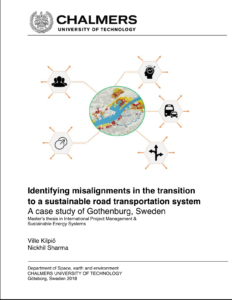VILLE KILPIÖ, NICKHIL SHARMA (2018)

Gothenburg is increasing in density and population as well as expanding its residential and commercial spaces. Due to increasing needs of the city, the current transportation system is expected to face challenges and needs to grow into a more robust, dynamic and accessible system. The City of Gothenburg has implemented the Climate 2030 strategy to curb emissions, and address other negative effects such as particulate emissions, noise, accidents and congestion that arise from road transportation. From this perspective, a host of new technologies and business models are being tested to achieve a more sustainable transportation system in the region. Therefore, this socio-technical system is undergoing a sustainability transition that involves interactions between a complex web of actors. Due to differences in visions, interests, perceptions and belief systems conflicts between these actors exist. This thesis explores the diverging interests and conflicts between actors in public administration, industry, and niche-level companies by answering the research question: What are the current misalignments in the transition to a sustainable road transportation system in Gothenburg? Answering the research question is relevant because existence of shared visions and alignment of perspectives leads to trust, stability and coherence of strategies which ensure a quicker transition. The main purpose of this thesis is to visualise the misalignments within the system and between actors and bring out the topics around which there is a clear conflict, and where there is common ground. The secondary purpose of thesis is to inspect the misalignments and understand their effects and implications. The preliminary research began by mapping of relevant actors using the multi-level perspective to get a comprehensive understanding of the system. The actors chosen included bureaucrats, executives from the freight and passenger transport industries, entrepreneurs and researchers. The main method of the thesis were semi-structured interviews which were complimented by the Q sorts and the workshop. This triangulation approach, to compare results from different methods, was done to check for consistency while formulating misalignments. Eleven semi-structured interviews were executed, followed by interviewees performing a Q sort, during which they classified statements representing different standpoints about the future system based on the level of their agreement with them. The final phase involved a workshop with a deep-dive into the causes of misalignments with the interviewees. Results were formulated as two types of misalignments classified under five misalignment clusters: (i) the speed and nature of transition (ii) roles of actors (iii) modes of transportation (iv) planning and (v) uncertainty in the system. The two types of misalignments presented were defined as strategic (present between actors) and systemic (present as contradictions within the transportation system). Further analysis of their effects and implications revealed that, strategic misalignments are bound to exist due to market competition, while systemic misalignments merit attention from all actors involved, since they present conflicts within the system that hinder the transition. As a final conclusion this thesis identified the following topics of interest for stimulating further research: (i) the role of policies in increasing market assimilation of technologies (ii) the uncertainties around the electrification of the transportation system (iii) the conflict between visionary and prognosis approach to planning and (iv) the standards required for data sharing between connected vehicles.





